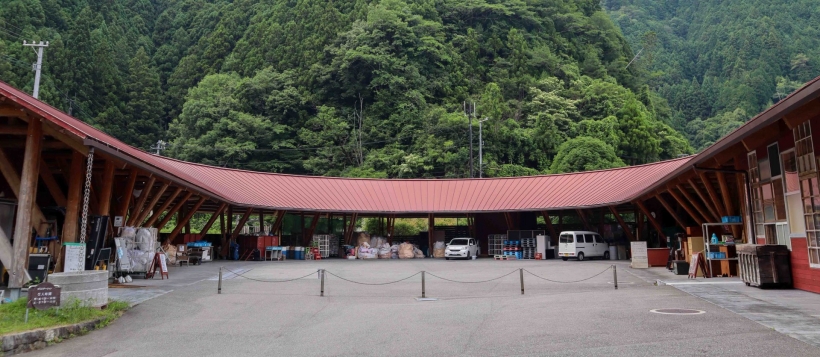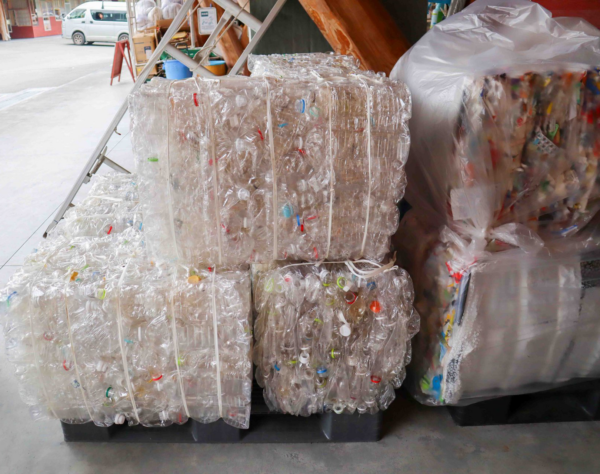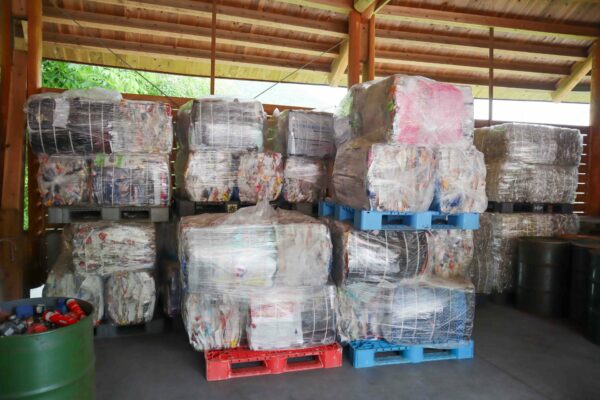The small town Kamikatsu with a mere population of about 1,300 citizens is attracting a lot of attention. The reason is that in 2003, it was the first local government in Japan to announce a “Zero Waste Declaration” and one of the first to work toward realizing a circular economy. The Orwak multi-chamber baler 5070-HDC supports the sites with compaction technology.
“Zero Waste” is a concept that aims to create a society, in which all waste is recycled as a resource and not sent to incineration or landfills. The town has moved away from the idea of simply disposing of waste and has thoroughly encouraged every resident to “separate and utilize” it.
In practice, a waste and resource separation system based on 43! different categories has been implemented in Kamikatsu. All items are separated and collected, from paper to plastics, metals, glass, clothing, and even smaller items such as toothbrushes and lighters. This initiative goes beyond simply reducing waste and has been highly praised both in Japan and overseas as an advanced model for aiming for a recycling-oriented society.
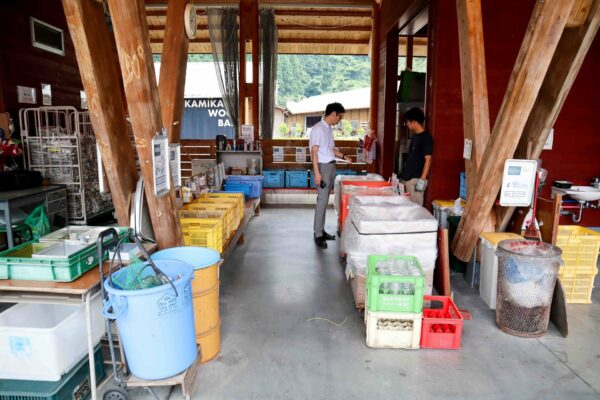
Orwak’s multi-chamber baler 5070-HDC has been installed at the Zero Waste Center, the town’s only facility for bringing in waste and recyclable resources. The baler is an indispensable tool for maximizing resource circulation taking into account limited space and manpower. What changes has the introduction of the 5070-HDC brought to waste sorting and resource circulation? We take a closer look at the ingenuity and the efforts made at the site as in the strive for “zero waste”.
New challenges arising from thorough sorting
The town’s recycling station, the Zero Waste Center, opened in year 2020 as a complex facility that includes a waste station for residents but also serves as a demonstration project. It is operated by BIG EYE COMPANY. Approximately 240 tons of waste and recyclable materials are brought to the center annually from 600 to 650 households in the town. On busy days, around 70 households bring their waste in, and the sorting and collection work is carried out by two staff members on weekdays (7.30 am to 2.00 pm) and three staff members on weekends (7.30 am to 3.30 pm).
Many of the sorted recyclables are bulky, making securing storage space a major challenge. Plastic containers and packaging, as well as PET bottles, are collected by recycling companies infrequently, once every 4 to 6 months, which puts a strain on the storage space.
Additionally, the task of manually re-sorting and packing each item was extremely tedious and increased the burden on the staff. When contractors collected and transported the items, loading efficiency was poor, resulting in higher costs.
To solve these on-site issues, the center needed compaction equipment and chose the multi-chamber baler 5070-HDC introduced by Orwak Japan.
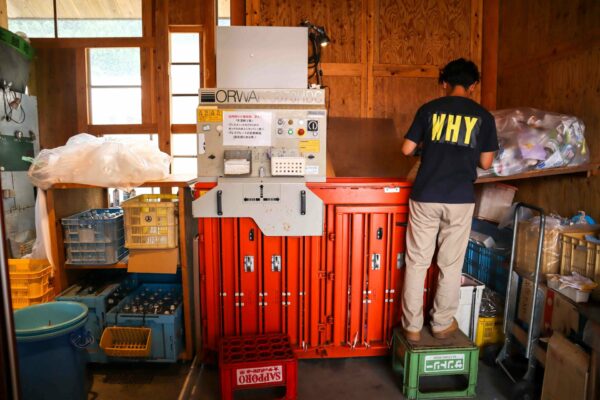
The deciding factors were the ability to compact:
- plastic containers, packaging and PET bottles in one machine
- to a standard that allows for delivery to the Japan Container and Packaging Recycling Association
- to a bale size that can be handled manually.
Compaction benefits: Improved storage and work efficiency
The baler was installed in a workshop near the collection site and the center began compacting plastic containers, plastic packaging and PET bottles.
Monthly Average Collection Volume:
- Plastic containers and packaging: 586 kg
- PET bottles: 199 kg
Storage Space Allocation:
- Plastic containers and packaging: approx. 9 m2
- PET bottles: Approx. 6 m2
- 3 bales x 2 layers per pallet; approx. 1 m2
Benefit 1: Increased storage capacity
- Plastic containers and packaging are reduced to about 1/5 and PET to 1/6 their original size, increasing storage capacity by 5-6 times.
- Maximum storage capacity is approx. 1.3 tons of plastic containers/packaging and approx. 900 kg of PET bottles.
Benefit 2: Reduced collection and transportation costs
- Transportation costs are reduced by 5-6 times.
Benefit 3: Reduced Workload
- Each bale weighs 20-30 kg and is compacted to 700x500x700 mm allowing a single staff member to handle it, improving safety and reducing workload.
- Significantly streamlines the process that previously required manual re-sorting and packaging for each item.
Benefit 4: Improved Hygiene
- Compaction reduces exposure to air, decreasing the risk of mold growth during long-term storage.
The challenge of improving waste separation further
The town’s zero waste policy has been successful in achieving a recycling rate of approximately 80 % so far, but 20 % of the waste is incinerated or sent to landfills, and this includes items that are difficult to recycle using current recycling technology, such as leather products, PVC products, sanitary products, composite material products etc. To turn the remaining 20 % into resources, the town is conducting experiments and collaborating with companies to improve recycling technology.
They work to establish new resource recycling routes and to encourage producers to “create products that do not become waste” and to change their sales methods.
Furthermore, they explore measures to reduce the burden on residents and systems that will make them feel the effort of sorting is worthwhile, such as reviewing the number of items sorted, systems to reduce the amount of washing required, expanding the scope of recipients for transportation support, and improving the point system. Measures that reflect the voices of residents are being considered based on the idea that “even if it takes effort, the burden can be reduced if the benefits are worth it.”
Why an advanced sorting site in small town Kamikatsu?
Kamikatsu has a unique history of not having a waste collection system using garbage trucks for a long time, and the residents sort their waste and recyclables and bring them to the Zero Waste Center. These unique local circumstances have led to thorough sorting and an advanced circular economy.
Although it would be difficult for other local administrations to completely copy Kamikatsu’s example, it continues to attract a lot of attention as a hint for creating systems for sorting and recycling resources. More than 2,000 visitors from Japan and abroad visit the site each year, making it a model case for local governments and businesses across the country.
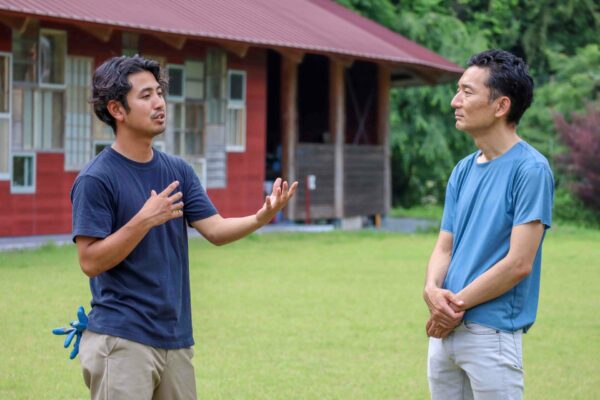
Zero Waste Center staff (left) discusses future prospects with Orwak Japan
The 5070-HDC, which is used at such advanced sites, goes beyond being a simple volume reduction machine; it comprehensively improves the site’s sorting capabilities, work efficiency, safety, and labor savings, and can be said to be one of the essential tools for realizing a circular economy.
The features and services, such as improved on-site efficiency by compacting multiple items simultaneously, high-density compaction, compact design and safety that fits the site, durability and a support system for long-term operation, are the reasons why this baler is chosen at sites where sorting is becoming more sophisticated and diversified.
More potential in high-rise buildings and urban areas
Furthermore, the town’s advanced zero-waste initiatives are being applied not only to the local government but also to urban buildings. The Torch Tower, currently under construction in Otemachi, Tokyo, and developed by Mitsubishi Estate Co., Ltd., will stand 385 m tall and encompass 62 floors.
Once completed, it is expected to be the tallest building in Japan. In this redevelopment project, Kamikatsu’s accumulated know-how is used to promote the “Circular City” concept, which aims for a 100 % waste recycling rate within the building. The zero-waste model originating from Kamikatsu will be deployed in a new field, and attention is being drawn to the realization of circular economy in urban areas.

The Orwak baler 5070-HDC will likely be used in an increasing number of locations in the future as the next-generation standard that supports the creation of a recycling-oriented, sustainable society. Along with Kamikatsu’s challenge, it is expected to spread throughout the country.
Shimpei Takanohashi, Sales Manager at Orwak Japan, comments:
“When Swedish innovation meets Japanese sincerity,
the future of a circular society begins to move.“






